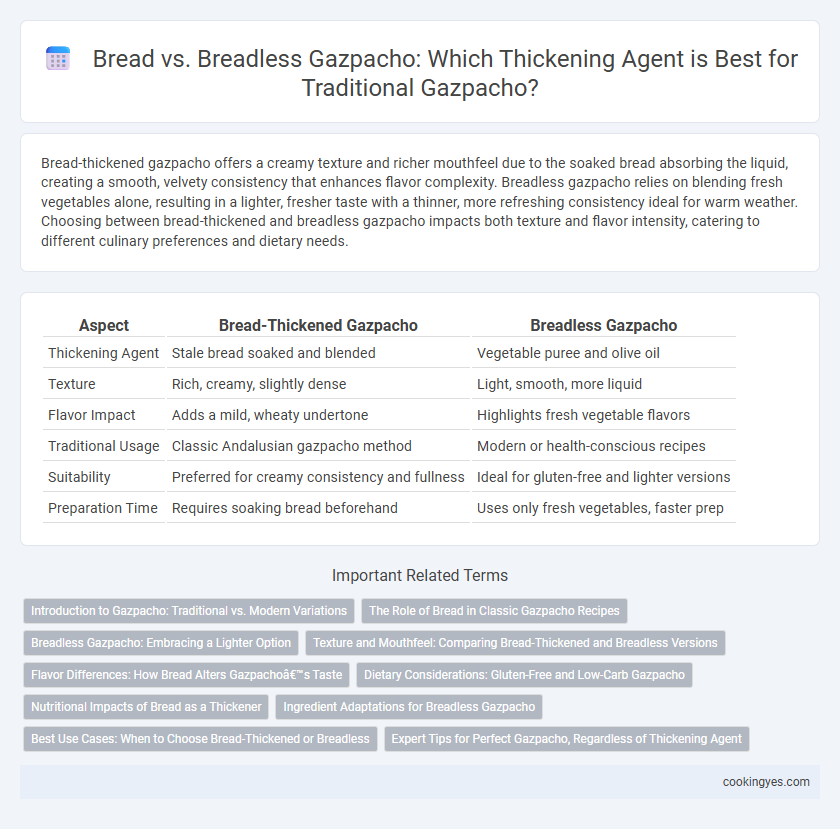Bread-thickened gazpacho offers a creamy texture and richer mouthfeel due to the soaked bread absorbing the liquid, creating a smooth, velvety consistency that enhances flavor complexity. Breadless gazpacho relies on blending fresh vegetables alone, resulting in a lighter, fresher taste with a thinner, more refreshing consistency ideal for warm weather. Choosing between bread-thickened and breadless gazpacho impacts both texture and flavor intensity, catering to different culinary preferences and dietary needs.
Table of Comparison
| Aspect | Bread-Thickened Gazpacho | Breadless Gazpacho |
|---|---|---|
| Thickening Agent | Stale bread soaked and blended | Vegetable puree and olive oil |
| Texture | Rich, creamy, slightly dense | Light, smooth, more liquid |
| Flavor Impact | Adds a mild, wheaty undertone | Highlights fresh vegetable flavors |
| Traditional Usage | Classic Andalusian gazpacho method | Modern or health-conscious recipes |
| Suitability | Preferred for creamy consistency and fullness | Ideal for gluten-free and lighter versions |
| Preparation Time | Requires soaking bread beforehand | Uses only fresh vegetables, faster prep |
Introduction to Gazpacho: Traditional vs. Modern Variations
Bread-thickened gazpacho utilizes stale bread as a natural thickening agent, giving the soup a richer, creamier texture and a slightly earthy flavor, true to traditional Andalusian recipes. Breadless gazpacho modernizes this classic by relying solely on pureed vegetables and chilled broth, resulting in a lighter, more refreshing consistency that highlights the freshness of tomatoes, cucumbers, and peppers. Both variations maintain the core gazpacho essence but differ in mouthfeel and caloric density, catering to diverse dietary preferences.
The Role of Bread in Classic Gazpacho Recipes
Bread in classic gazpacho serves as a key thickening agent, providing a creamy texture and balancing the acidity of tomatoes. It enhances the soup's body without overwhelming the fresh vegetable flavors, distinguishing traditional recipes from breadless versions that rely solely on vegetable puree for viscosity. The presence of bread also contributes subtle yeast notes and a more filling mouthfeel, which are integral to authentic Andalusian gazpacho profiles.
Breadless Gazpacho: Embracing a Lighter Option
Breadless gazpacho embraces a lighter option by relying on pureed vegetables like cucumber, bell peppers, and tomatoes for natural thickness instead of traditional bread. This method reduces calories and carbohydrates while intensifying the fresh, vibrant flavors typical of Andalusian cuisine. The absence of bread also makes it suitable for gluten-free diets, appealing to health-conscious consumers seeking refreshing, nutrient-dense cold soups.
Texture and Mouthfeel: Comparing Bread-Thickened and Breadless Versions
Bread-thickened gazpacho offers a creamy, velvety texture with a rich mouthfeel due to the soaked stale bread absorbing the tomato juice and olive oil, resulting in a smooth and slightly dense consistency. Breadless gazpacho, relying solely on blended vegetables and sometimes cucumbers, delivers a lighter, fresher texture with a more pronounced crispness and a cleaner, more refreshing mouthfeel. The choice between these versions hinges on the desired balance between richness and lightness, with bread-thickened options providing a heartier experience and breadless gazpachos offering a vibrant, hydrating sensation.
Flavor Differences: How Bread Alters Gazpacho’s Taste
Bread-thickened gazpacho offers a richer, creamier texture and imparts a subtle, yeasty flavor that enhances the overall depth of the soup. Breadless gazpacho, relying solely on vegetable ingredients, delivers a fresher, brighter taste with a more pronounced tomato and cucumber profile. This fundamental difference in thickening agent directly influences the soup's mouthfeel and the balance of flavors, making bread a key factor in traditional Andalusian gazpacho recipes.
Dietary Considerations: Gluten-Free and Low-Carb Gazpacho
Bread-thickened gazpacho traditionally uses stale bread to add texture and body, but this increases gluten content and carbohydrates, making it unsuitable for gluten-free and low-carb diets. Breadless gazpacho substitutes pureed vegetables or avocado to achieve thickness without gluten or excess carbs, catering to dietary restrictions like celiac disease and ketogenic lifestyles. Choosing breadless versions supports those seeking nutrient-dense, low-gluten, and low-carbohydrate options while maintaining the refreshing qualities of classic gazpacho.
Nutritional Impacts of Bread as a Thickener
Bread-thickened gazpacho contains carbohydrates and added calories that contribute to energy intake and provide dietary fiber, beneficial for digestive health. Using bread as a thickening agent increases glycemic load compared to breadless gazpacho, which is typically lower in calories and carbohydrates. The choice impacts nutritional content, favoring a heartier, fiber-rich option versus a lighter, lower-carb alternative.
Ingredient Adaptations for Breadless Gazpacho
Breadless gazpacho uses alternative thickening agents like blended avocado, cucumber, or soaked nuts to maintain a creamy texture without traditional bread. These ingredients enhance the soup's nutritional profile by adding healthy fats and fiber while preserving the refreshing and vibrant flavor characteristic of gazpacho. Adjusting the ratio of liquid vegetables and oils ensures optimal consistency and mouthfeel in breadless variations.
Best Use Cases: When to Choose Bread-Thickened or Breadless
Bread-thickened gazpacho offers a creamy texture ideal for traditional Andalusian recipes and occasions requiring a richer, more filling dish, especially served as a starter or light meal. Breadless gazpacho is best suited for low-carb or gluten-free diets, refreshing summer servings, or when a lighter, more vibrant flavor profile highlights fresh vegetables without added heaviness. Selecting between bread-thickened and breadless versions depends on dietary needs, desired consistency, and the culinary context of the meal.
Expert Tips for Perfect Gazpacho, Regardless of Thickening Agent
Achieving the perfect gazpacho consistency hinges on the choice of thickening agent; bread-thickened gazpacho offers a creamy texture and richer mouthfeel due to soaked stale bread, while breadless versions rely on pureed vegetables like cucumber or avocado to provide natural thickness and freshness. Expert tips include balancing acidity with ripe tomatoes and vinegar, chilling the soup thoroughly for enhanced flavor meld, and adjusting seasoning incrementally to suit the thickening base. Using high-quality, fresh ingredients ensures vibrant taste profiles whether using traditional bread or modern breadless techniques to achieve ideal gazpacho.
Bread-thickened gazpacho vs Breadless gazpacho for thickening agent Infographic

 cookingyes.com
cookingyes.com